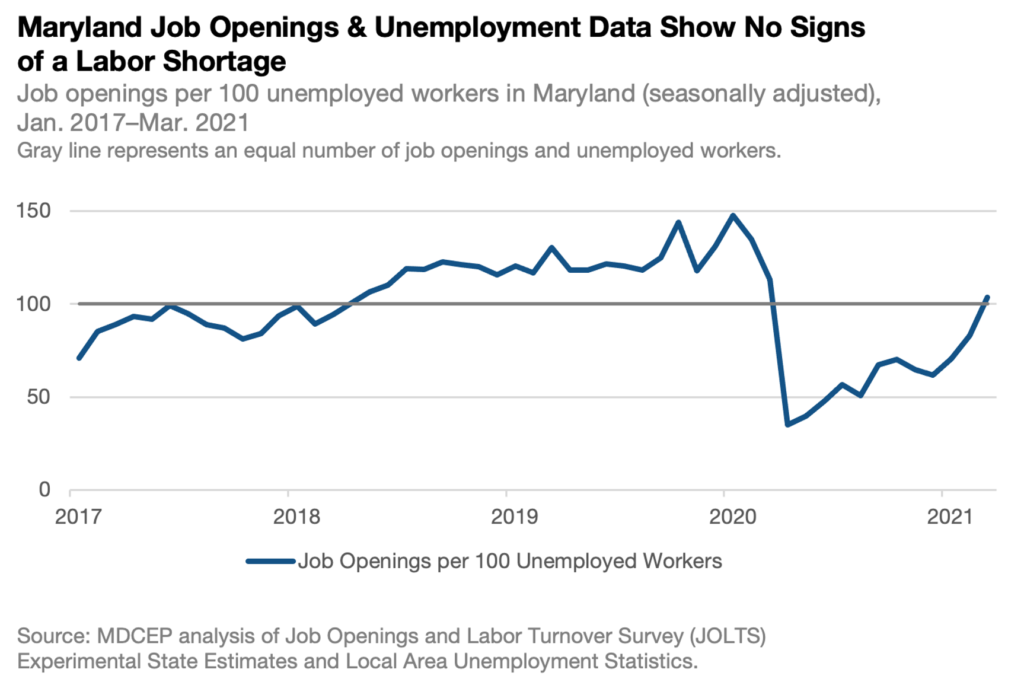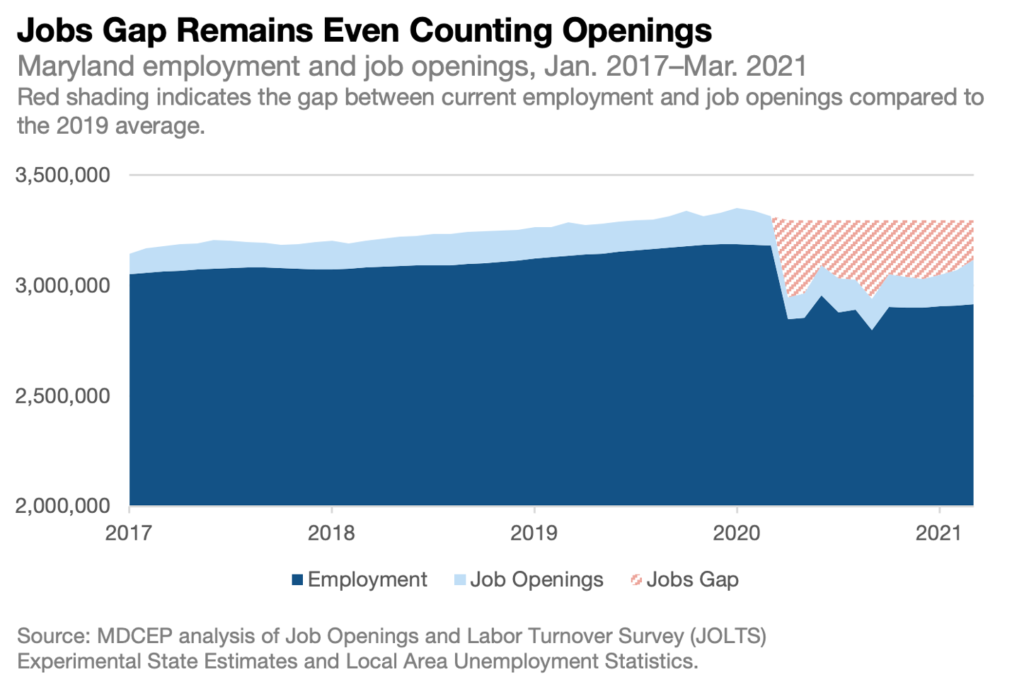Cutting Off Unemployment Benefits Would Sap $2.4 Billion from Maryland’s Economy
New analysis by the Maryland Center on Economic Policy shows that Gov. Hogan’s plan to prematurely cut off federal unemployment expansions established in response to the coronavirus pandemic would shrink Maryland’s economy by $2.4 billion.
Context
Gov. Hogan announced June 1 that, effective July 4, he would discontinue four federally funded enhancements to unemployment insurance that Congress created in response to the coronavirus pandemic:
- Federal Pandemic Unemployment Compensation (FPUC), which provides an additional $300 per week
- Mixed Earners Unemployment Compensation (MEUC), which provides compensation to workers whose work history includes both self-employment income and income from an ordinary job
- Pandemic Emergency Unemployment Compensation (PEUC), which provides benefits beyond the shorter eligibility period of regular unemployment insurance
- Pandemic Unemployment Assistance (PUA), which provides benefits to workers who are not eligible for regular unemployment insurance because they are self employed, have been misclassified as an independent contractor, or have exhausted benefits provided under other unemployment insurance programs
Under federal law, these programs are slated to expire September 6. The governor’s decision will deprive unemployed workers and Maryland’s economy of a vital lifeline two months earlier than necessary. The forgone unemployment payments—funded entirely by the federal government—are expected to total $1.5 billion, according to the state Comptroller’s office.[i]
Unemployment Benefits Support Local Economies
Unemployment payments enable workers and families to put food on the table, keep a roof over their heads, and pay for other necessities as they pick themselves up from the loss of a job. They are also an essential tool to support a robust economic recovery for the entire state.
As we recover from the pandemic’s economic toll, maintaining consumer demand is key to boosting sales at local businesses and bringing back jobs. Unemployment benefits are a highly effective tool for boosting demand. More than anyone else, families living paycheck to paycheck quickly cycle every dollar of income back into the local economy by buying essentials.[ii] Unemployment payments put money in the pockets of precisely the families who will spend that money fastest. This, in turn, means stronger sales at local businesses, which allows them to preserve more jobs. In contrast, cutting off benefits further squeezes families who already struggle to afford the basics. When families have no choice but to cut back, this means less demand for businesses’ wares and fewer jobs to go around.
Because of these feedback effects—unemployment payments help families afford essentials, boosting sales at local businesses, supporting increased hiring, which helps more families afford essentials—the ultimate impact on the economy is greater than the amount of the payments themselves. Analysis by the Congressional Joint Economic Committee finds that each $1.00 in Federal Pandemic Unemployment Compensation generates $1.61 in economic activity.[iii]
Applying this multiplier to the unemployment payments our state will lose if Gov. Hogan’s decision to cut off benefits takes effect, the total cost to Maryland’s economy is $2.4 billion.
There is No Justification for Cutting Off Benefits
Cutting off unemployment benefits early would harm unemployed workers and Maryland’s economy in clear, well-documented ways. In contrast, the stated rationale for taking away benefits does not stand up to scrutiny.
Scant Evidence of Worker Shortages
Despite a wave of anecdotes promoted by special interest groups and amplified by media, there is not meaningful evidence that a lack of workers is holding back our economy.
In March 2021—the most recent month for which data exist—there were 193,000 unemployed Marylanders and 200,000 job openings.[iv] This means that there were 103 job openings for every 100 unemployed workers, essentially an even balance. Maryland’s labor market last passed this milestone in April 2018—and then kept growing for 20 straight months. In 2019, there were an average of 123 job postings per 100 unemployed workers.[v] Even factoring in job growth that has occurred since March, it is clear that Maryland’s labor market has plenty of room to expand.
It is possible to estimate how many people businesses would like to employ by adding together the number of employed workers in Maryland and the number of job openings. In 2019, the sum of employment and job openings in Maryland averaged 3.30 million. As of March 2021, that number was only 3.12 million—lower than at any point in 2017, 2018, or 2019. Even if employers instantly filled every current job opening, Maryland’s economy would still be 179,000 jobs short of where it was in 2019.
Other Factors More Relevant to Job Growth
Furthermore, evidence does not support the idea that taking away unemployment benefits would get workers back into jobs any faster.
The U.S. Census Bureau’s Household Pulse Survey regularly asks respondents who are not employed why they are not currently working for pay. In mid-June, Maryland adults named a variety of reasons unrelated to unemployment insurance:[vi]
- 17% are caring for children or aging relatives
- 16% have a disability or an illness other than COVID-19
- 15% lost their job because of the pandemic
- 6% are concerned about catching or spreading COVID-19
- 5% have COVID-19 symptoms or are caring for someone else with COVID-19 symptoms
- 1% Do not have transportation to work
- 94% report that they want to be employed.
Similarly, a survey of job seekers by the Indeed Hiring Lab found that even among workers whose job search is not in an “urgent” phase, care responsibilities and concerns about COVID-19 were the most important factors keeping them from a more aggressive job search.[vii] Even within this subgroup of “non-urgent” job seekers, only about 10% mentioned unemployment benefits as a relevant factor. Contrary to the ”worker shortage” narrative, workers continued to experience the labor market as scarce. More job opportunitieswere the number-one milestone respondents said would prompt them to intensify their job search.
In short, cutting off unemployment benefits is a cruel, counterproductive measure that is ill-suited to solve a problem that largely does not exist.
[i] “Franchot to Speak Today at Rally to Restore Federal Unemployment Aid,” Comptroller of Maryland, June 4, 2021, https://content.govdelivery.com/bulletins/gd/MDCOMP-2e2902d?wgt_ref=MDCOMP_WIDGET_C7
[ii] Christopher Carroll, Jiri Slacalek, Kiichi Tokuoka, and Matthew White, “The Distribution of Wealth and the Marginal Propensity to Consume,” Quantitative Economics 8(3), 2017, https://onlinelibrary.wiley.com/doi/10.3982/QE694
[iii] “Local Economies Stand to Lose More Than $12 Billion Due to Early Cancellation of Enhanced Unemployment Benefits,” Joint Economic Committee, June 2, 2021, https://www.jec.senate.gov/public/_cache/files/1f9672bb-2ce0-40ff-acde-aede9b99867f/fpuc-and-gop-govs-06.02.2021.pdf
[iv] MDCEP analysis of Job Openings and Labor Turnover Survey Experimental State Estimates and Local Area Unemployment Statistics.
[v] MDCEP analysis of Job Openings and Labor Turnover Survey Experimental State Estimates and Local Area Unemployment Statistics.
[vi] MDCEP analysis of Household Pulse Week 32 data for Maryland adults, June 9 to June 21, 2021. Percentages are among adults who are neither employed nor retired.
[vii] Nick Bunker, “Indeed Job Seeker Survey June 2021: COVID Concerns and Financial Cushions Make Job Search Less Urgent,” Indeed Hiring Lab, June 29, 2021, https://www.hiringlab.org/2021/06/29/indeed-job-seeker-survey-june-2021/



